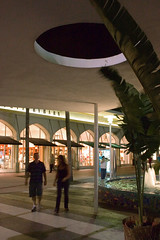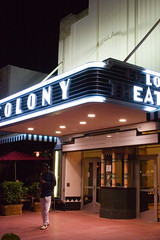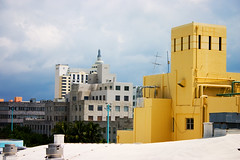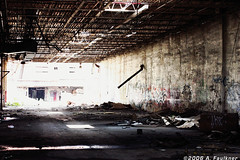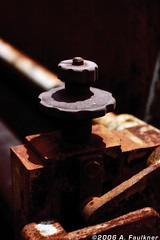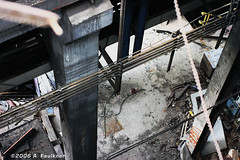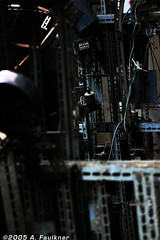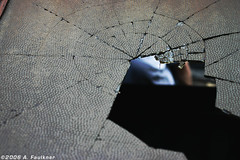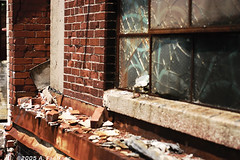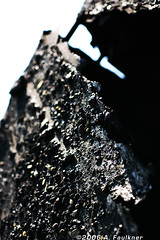Evan at
Tenuous Resilience recently had a post that caused me to reflect further on a number of issues and perhaps reconsider subcultural praxis. Evan wrote that, in his experience, the most engaging fragments of architecture are the ones that are considered the most dangerous from a conventional viewpoint.
He continues:
"So, what is the essence of this problem? Is the US legal system so rife with frivolous lawsuits that building codes must comply to ridiculous standards that forsake any possibility of personal responsibility? Is the protection of our populous so important to our policymakers that we must eliminate every possible source of harm? What happened to the America that was wild and exciting, where anyone could strive for their dreams or die trying, where the very real possibility of failure made the win that much richer? How did we become a nation of frightened hermits, isolated in our armored cul-de-sacs and SUVs? What happened to ambition? Where are the foolhardy?
I think the illusion of safety perpetuated by building codes, warning labels, commercial drugs, and the security-obsessed government is killing our national spirit... Despite the state of the middle east, the American people have not been asked to make any sacrifices, and though we are a "nation at war" you certainly can't tell by the home front. Would a "Manhattan"-scale project for sustainable, green power be enough to wean our economy from unstable foreign oil? Perhaps more importantly, who would benefit from such a project?" I would first like to address the dialectical relationship between control (vis-a-vis safety codification) and responsibility. This happens to be the one point that I can agree on with my friends who also happen to be professed anarchists. While I hold deep reservations (stemming from my Conrad/Golding influenced conception of human nature) about the human repercussions of abandoning codified strictures of behavior, I will readily admit that too much control yields an immature and potentially irresponsible citizen.
The more that the dangers of the world are kept at arm's length, the more people slip into a protracted state of infantilism. This trend has dire repercussions for the future as it has in the past; as Evan alluded, our current war is essentially a war by proxy for there is no reciprocal war on the homefront. Currently in Iraq the proportion of mercenaries to soldiers and official government representatives is 1:6. Not unlike the end centuries of Rome when the legions were staffed with the same barbarians who would shortly sack the eternal city, (their salaries paid by rich senators who disdained the risk of battle) this phenomena will only grow more severe in the coming years. This unfortunately is a self perpetuating cycle; as we continue to wage wars and inflect misery around the globe without any meaningful correlation at home, we, as a population, can easily forget the devastation occurring far away and can become distracted by Bennifer, TomKat or whatever other trifling matter grabs headlines and seizes our collective (un)conscious.
Our utter disconnection and distraction will only serve to get us more embroiled as we fail to fulfill our role by asking difficult questions of our leaders. Furthermore, as other peoples see our inability to concentrate on what our very own government (or elite) is perpetrating, our problems will only worsen. Could it not be argued that the strictures, rules, and codes that protect us ourselves, and by extension, the pain of life can be understood not only to maintain, but to enhance the status quo by allowing us to be distracted by our bread and circuses?
There is a fascinating inversion to the menace of complacency brought about by the metastasizing illusion of safety and all-consuming
desire for this chimera that occurs primarily on a subcultural level; as our species has dealt more or less successfully with danger for millennia a need for it has become ingrained in our psyche. Such subcultural phenomena as ultimate fighting or even extreme sports (although at this point their ability to generate profit seems to have made them defacto cultural components of the status quo) exist to fulfill the basic need for danger vis-a-vis the "rush" or adrenaline high generated as a protective impulse due to extreme stress.
In addition to the segment of pure adrenaline junkies there is a large proportion of seemingly rational people who place themselves in harm's way simply for the emotional and mental immediacy generated through such an action. I have heard climbers describe that the joy they get from conquering a vertical cliff face stems from the complete mental focus and utter lucidity they experience as they contemplate where to find safe handholds. I can personally attest that the experience of having to vault off of a impassable catwalk to the flange of a rusted generator thirty feet above the floor
in a derelict power station cut like a hot knife through the butter of the fog of everyday life. Before I ramble on for too long I would like to close with a question: if we agree that the unexamined life is not worth living, can we also posit that a life safe from harm and challenge is not a life at all?




